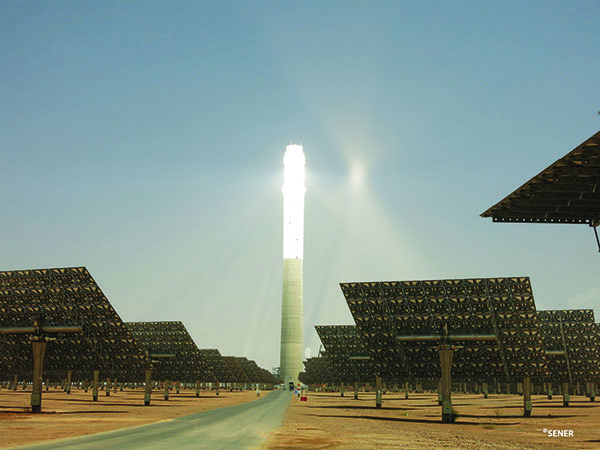Moroccan Molten Salt Tower Project Clears Reliability Test
A 10-day reliability test for the 150-MW Noor Ouarzazate III thermoelectric solar plant in Morocco has wrapped up, demonstrating that the project can provide continuous rated power even in the absence of sunlight.
The project is part of the largest concentrated solar complex in the world. The 510-MW Noor solar complex in Ouarzazate, which is run by the Moroccan Agency for Sustainable Energy (MASEN), also includes the 160-MW Noor Ouarzazate I and 200-MW Noor Ouarzazate II plants. Both feature parabolic trough technology designed by Spanish engineering and technology group SENER. The $3.9 billion Noor I project, which came online in February 2016, has a three-hour molten storage capacity and a wet-cooling system. Noor II, which came online this April, uses second-generation SENERtroughs, dry cooling, and features six hours of storage capacity. A fourth project, the 70-MW Noor IV also under construction is a solar photovoltaic plant.
Noor Ouarzazate III (Figure 5), however, is a central receiver plant that uses heliostats and salt receiver technology. It is dry-cooled and has a storage capacity of 7.5 hours. SENER provided the project's 600-MWth high-power solar receiver, which is located within the 250-meter-high tower. The project features the same configuration that SENER applied at the 20-MW Gemasolar plant, in Seville, Spain, which became the world's first commercial-scale power plant to apply central tower receiver and molten salt thermal storage in April 2011. Noor Ouarzazate III, which is seven times larger than Gemasolar, "is the natural evolution from this pioneering facility and [includes] advances such as HE54 heliostats, a larger heliostat, designed and manufactured by SENER," the company told POWER in November.
 |
5. Towering expectations. A consortium formed by SENER and SEPCO III completed reliability tests for the 150-MW Noor Ouarzazate III thermoelectric solar plant in November. The plant, which is equipped with a molten salt storage system, ran for 10 straight days, providing 13.2 GWh to Morocco's grid. Courtesy: SENER |
In a recent paper published by the American Institute of Physics, SENER noted its success in building the massive 550-hectare project lies in being fully responsible for the plant design as well as key components. SENER also had 50% of the engineering, procurement, and construction contract share. Noor III's design was chosen and optimized using simulation software that can calculate annual plant performance, estimating project costs, and managing thousands of design alternatives. "There is a lack in the market of appropriate tools for a proper simulation of [molten storage thermal] plants," it noted. One issue faced by plant developers is that simulators cannot gauge exact limitations and plant configuration of the receiver that they are trying to represent-and that can result in "significant differences between simulated annual results and real plants in operation."
Five years of operation at Gemasolar also provided SENER with valuable input in designing the 54-facet HE54 heliostat, which has a reflective surface of 178.5 square meters. That compares to 115.7 m 2 in Gemasolar's 35-facet HE35 heliostats. SENER hopes that its technology developed at Noor III will be applied in molten salt tower plants planned in South Africa, Chile, and Australia.
Now that Noor III's reliability test has been completed, the project nears commercial operation, but SENER did not provide a concrete date. The massive Noor complex is integral to meeting Morocco's rapidly growing power demand, which is linked to soaring economic growth. The country's access to power increased to 99.5% in mid-2017, compared to only 50% access 10 years ago (and 18% in 1995), according to the World Bank. After years of stagnation, the country increased its capacity by 2 GW between 2013 and 2016, most of it built by the private sector, and in line with the National Energy Strategy, 60% of those additions were renewables. At the end of 2016, 48% of the country's power was generated by coal; 17% by natural gas; 13% by hydro, wind, and solar; and 8% by diesel and fuel oil, while the remainder came from Spanish imports.
-Sonal Patelis a POWER associate editor.
The post Moroccan Molten Salt Tower Project Clears Reliability Test appeared first on POWER Magazine.